In case you have missed the news lately, it has been raining in Texas . . . a lot. We’re talking like every day, heavy, flash flood rain, which has ended up landing May 2015 in the top 3 of the rainiest months in Texas in history.
It’s been really strange dealing with all of this rain. Since we moved here in the summer of 2008, Texas has been in a state of drought. Rain was so rare here that I got rid of all of our umbrellas, rain boots, and even rain coats. We even had a large tree in our front yard die from drought conditions a few years ago.
Well, I feel like I’m living in Seattle now! The good news of all this rain though is that Texas is no longer in a drought and I can finally do some gardening without fear of everything I plant drying right up!
I mentioned last week that I have been working in my yard a lot. After the Vintage Market Days, I needed to take a break from painting furniture and shopping flea markets.
I have been spending most of my time working on our front yard, which has been a in terrible state for years now (read more about the Poisin Ivy infestation that caused that here). The only bright spots in my front yard landscape for the past few years have been the beautiful knockout rose bushes I planted to frame my front door.

They are advertised as being basically the easiest plant to grow, and really they have lived up to their billing. My knockout rose bushes have been one of the few things I have planted over the past few years that have thrived. Until now . . . the dreaded Rose Rosette Disease just showed up.
I am by no means a gardening expert, but every spring I try to learn a little bit more about local plants and about what I have in my yard.
Well, driving around town this spring I started to notice this weird red growth coming out of all of the knockout rose bushes planted around town.
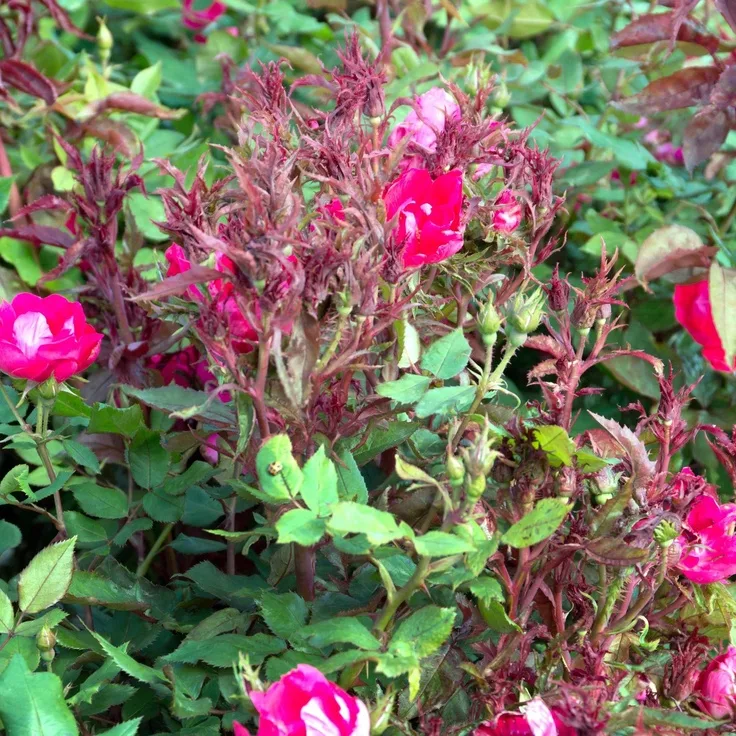
via Pinterest
I had heard rumors of some dreaded disease coming to wipe out all of the knockout roses, but honestly I just thought this was their new growth. A little internet searching though proved me wrong. Turns out these weird, red stalks are one of the telltale signs of Rose Rosette Disease, or RRD if you want to speak the hip gardening lingo.
RRD is a virus spread by mites that can infect all roses. However, since so many knockout roses have been planted over the past few years (many of them in mass plantings around commercial areas and by novice gardeners like me who just want an easy plant), RRD has been able to quickly spread from one knockout to another. As I look around town, it looks like it’s infected every knockout rose I see.
So last week I took a good look through my two lovely knockouts, hoping they were still healthy. But instead I found those nasty red stalks.
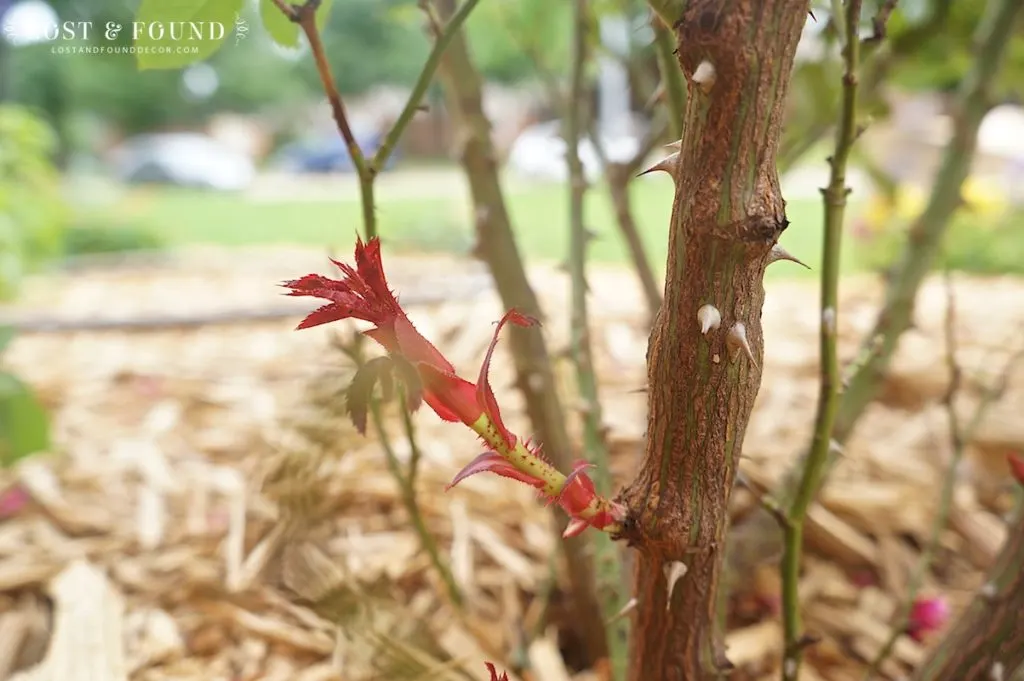
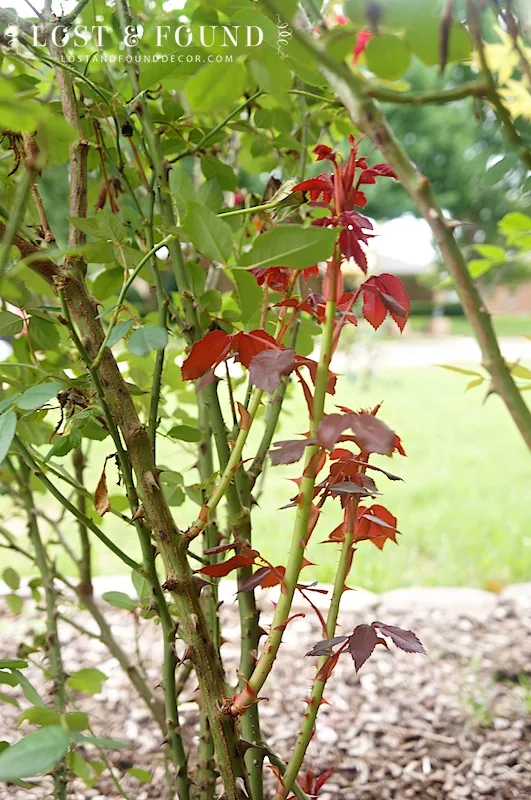
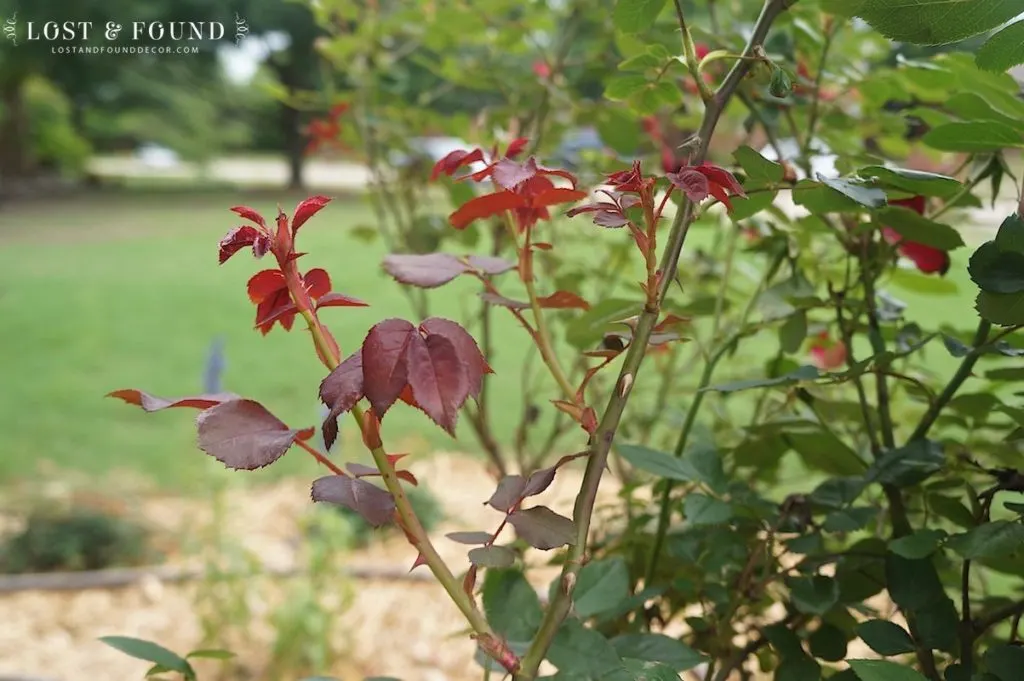
The experts say that once you have a rose infected with RRD, there’s nothing you can do. In fact it is recommended that you completely remove the infected shrub, including all of its roots, as soon as possible. The longer you leave your RRD infected rose growing, the more likely you will help spread the disease to your neighbor.
And thus is the problem . . . I think most of the roses around town were infected last year, but nobody knew it, so they stayed in place. Honestly, I am pretty sure I saw the weird red stuff on my roses last year, but just thought it was normal. Even now, I am not seeing those big mass plantings around Target and such being removed, and I see RRD infected roses in my neighbors yards every day. So really we have all unknowingly participated in allowing the spread of this nasty virus. So sad.
Well, I dug up my roses. I have read that once the soil lays empty for a week, you could replant a new rose in the same spot and it should be fine. But why plant another knockout when so many diseased bushes are still around?
I am now trying to figure out what I want to do with the spaces next to my front door.
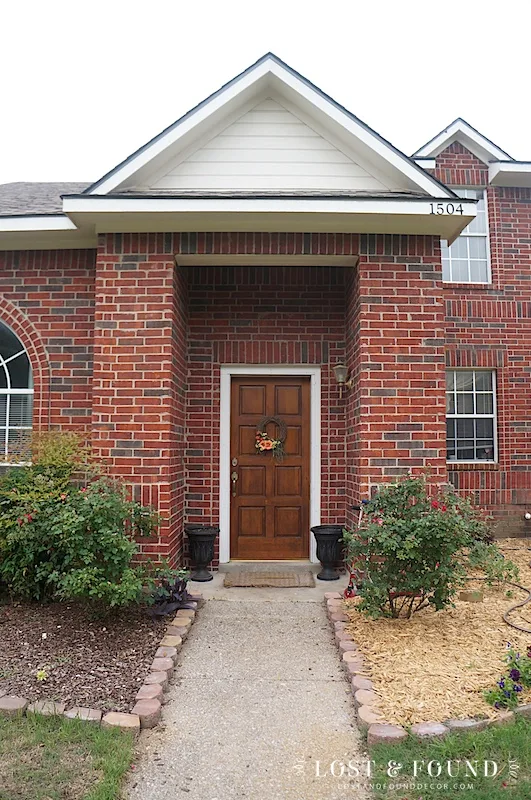
You can see the roses on the left and right before I pulled them out. They were a nice spot of color, easy to maintain, and not too large.
A landscaping design friend suggested planting two tall shrubs to draw your eyes upwards to our tall doorway. I think I disagree though . . . I feel like large, tall shrubs would crowd the doorway space and make it feel cramped.
I know I would like to plant some dwarf spirea,
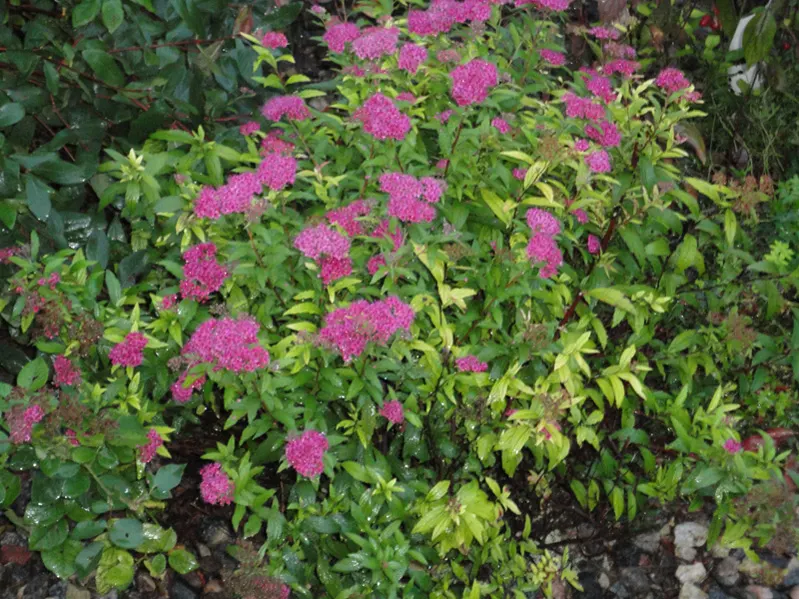
but I think the space needs something else too. Should I plant some vines that would climb up the front brick? Or maybe some ornamental grasses that would be taller, but still feel light?
I would love any thoughts you may have. Whatever I am going to plant, I need to do it soon to take advantage of all of this crazy rain!
Like my 8 year old would say, the moral of this story is to be sure to check your own knockout rose bushes! My dad was visiting from Tennessee as I was looking at mine, and he found RRD on two of his bushes when he made it back home. He had never heard of it and has seen no mention of it since in his local publications. Don’t be a disease spreader!
I miss my knockouts, and maybe one day I will plant more once this RRD is under control. But for now they will have to stay away from my yard.
I wish you all a disease-free yard and a happy weekend 🙂
**Update 5/31: After receiving some feedback on FB, I have read some additional material about red growth on knockout roses, and some red growth may be legitimate new growth rather than a sign of RRD. The photos I have posted of the red growth on my own roses may not be the best examples of RRD, however earlier this spring the tops of both bushes did have the distinct RRD red growth in small spots. Rather than risking spreading the RRD virus, I decided to go ahead and remove my bushes, feeling confident that they were infected. Be sure to take photos and ask your local gardening expert however before removing any roses in your yard. Thanks!


Sharon
Tuesday 2nd of June 2015
Our whole area is infected, too. Some of my neighbors have begun the removal process, but you know that's been difficult with all of the rain. I'm just sick about it. I think it's fairly obvious when your roses have it because the blooms disappear practically overnight! One day they were beautiful and the next nothing. As to what to replace them with, I'm not sure. My husband suggested azaleas but I'm not sure they'll do well here. Best of luck with whatever you plant!
Melanie
Tuesday 2nd of June 2015
I am sorry to hear that Sharon! Maybe in a few years they will be able to come back. They really are so beautiful and it's a shame they are seemingly wiped out. I so wish we could plant azaleas here, but we don't have the right soil or enough shade. Being a southern girl though, I miss my big azaleas! What are of the country are you in?
Deb
Monday 1st of June 2015
I think a blue arrow juniper would look great on each side of your entrance. I too lost my rose "William Baffin" from rose rosette disease, ticked me off I'd had them about 5 years and they were perfect. No more roses for me!
Melanie
Tuesday 2nd of June 2015
Oh Deb I'm sorry! It is sad to lose something you enjoy so much and work hard to take care of. Thanks for the juniper suggestion. I am looking for something affordable too, and sometimes those nicer, tall shrubs are quite pricey. Maybe I can find a deal though if I wait to look at the end of summer.
Quandie
Monday 1st of June 2015
Isn't it a bummer when an old standby goes by the wayside? I've had the same problem here in Minnesota with Impatiens. I used to love to add them to my shade gardens for a reliable pop of color, but then a virus started spreading that caused them to die right down to the ground mid-summer. This particular virus will infect the soil, so if you plant Impatiens in the same spot the following year, they will become infected as well. So sad. On another note, I agree with your friend, you need something with some height in those spots because your entryway is so tall and commanding. Or, you could hang something on the brick, like matching trellises or a pair of large lanterns. Personally I would not want to try adding wiring, so how about some huge lanterns with candles inside?
Melanie
Tuesday 2nd of June 2015
Boo about your impatiens! I have heard of that around here as well. That's so frustrating though that the virus also affects the soil. I really am torn about the plants for the entrance. When we moved in there were two, very tall, overgrown shrubs flanking the entrance and I always felt squished whenever I walked into our front door. I love the lantern idea! We only have one puny, little porch light and two big lanterns would be so much nicer. I wonder how pricey it would be to add the wiring . . . it may be a pipe dream but at least worth looking into. Thanks for the suggestions :)
teresa
Monday 1st of June 2015
Maybe you could try bare-root next year. I'd avoid the big box stores for roses.
Melanie
Tuesday 2nd of June 2015
I'll take a look at that Teresa, thanks!
chris aka monkey
Saturday 30th of May 2015
so sorry mel i love my knock outs and i don't have that just something eating the heck out of them i am almost over roses xx
Melanie
Tuesday 2nd of June 2015
I wonder what is eating them? We have an entire universe of snails that live in our yard as well, and they like to eat my basil.